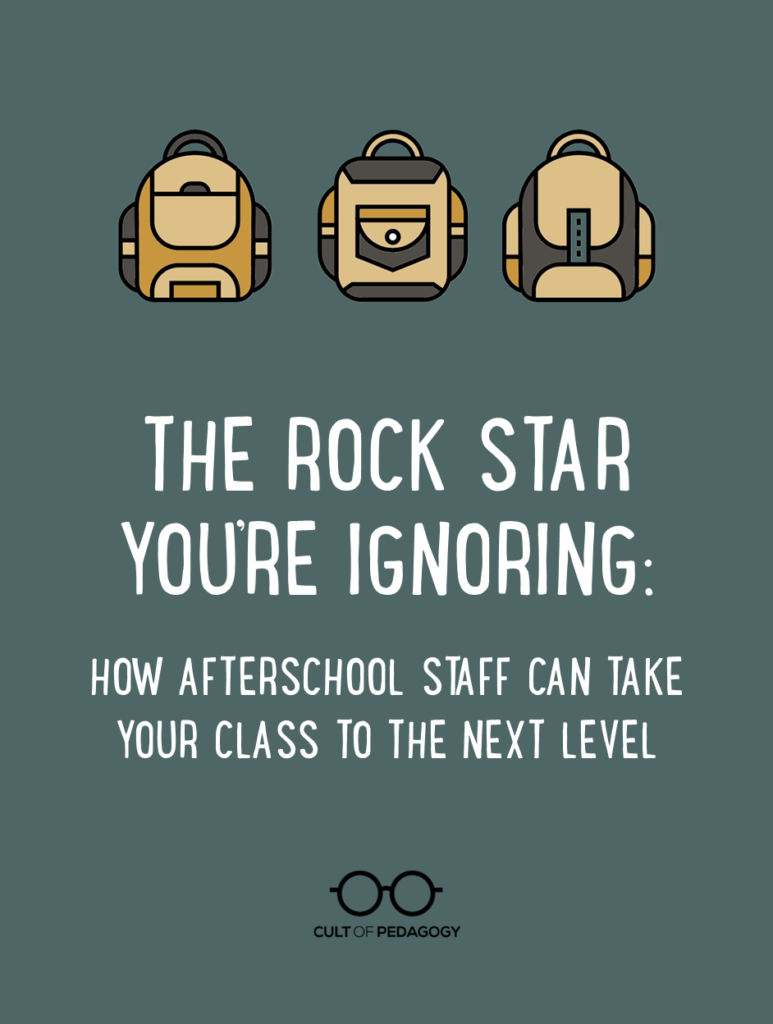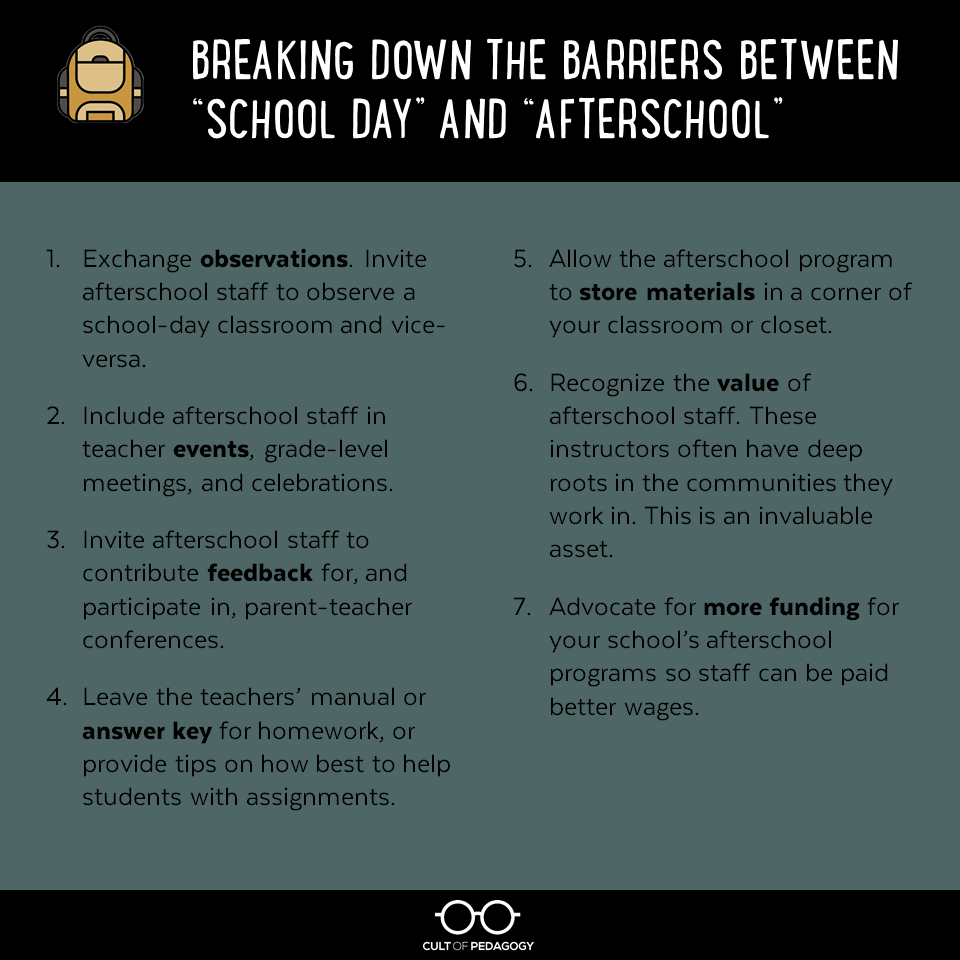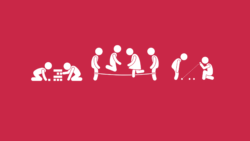
Listen to my interview with Eva Jo Meyers:
Sponsored by Pear Deck and Participate
When I was a teacher in New York in the late ‘90’s, the afterschool program at my school felt invisible at best, and annoying at worst. The afterschool staff were like shadows to me, vaguely showing up on the recess field as I dismissed my class, disappearing as I headed out the door. I don’t think I ever even knew their names.
When the program did catch my attention it was because of annoyances: having to vacate my classroom directly after school, the classroom being messier in the morning than I had left it in the afternoon, or finding classroom tools misused or ruined (like an expletive being scratched into the top of my prized classroom piano).
Ironically, when I left teaching, I began what would turn into a career in afterschool. My frustration at being unable to connect with teachers in my afterschool role was only paralleled by my embarrassment at how oblivious I had been when I was a teacher. I began to see that there were endless opportunities for teachers to work with afterschool staff; these partnerships and collaborations had the power to vastly improve the support available to students—and our school community as a whole. As part of the growing village around our children, I could see teachers’ potential to create a mutually beneficial relationship that dissolves the line between who is an “educator” and who is not.
When we break down the barriers between “school day” and “afterschool,” we are taking a giant step towards being in full service to our students and families. Here are few places to start doing just that:
1. Exchange Observations
One way to start bridging the school day with afterschool is to invite afterschool staff and leadership to observe and/or participate in your classroom. Likewise, classroom teachers could observe the afterschool activities.
At one school I worked with, afterschool staff were invited by teachers into the classroom to lead the end of the day closing. This usually took the form of a check-out circle where students could share something they learned that day, something they were looking forward to the next day, someone who helped them, etc. It only took about ten minutes, but provided a seamless transition between adults in charge and helped establish connections between both students and adults.
I have also worked with schools that invited afterschool staff to come in for a full morning or day to observe what their students were doing in the classroom. This helped open up conversations about teaching strategies, behavior systems, and classroom expectations, and even led to conversations on how to support specific students, with both sides contributing ideas. Afterschool staff may not always have the availability to do this, but without inviting them, they certainly won’t show up.
As a school-day teacher, you could ask to participate in the afterschool program for a day, an hour a week, or ten minutes at the start of each afternoon. If the afterschool program is putting on an end-of-semester performance or event, make an effort to attend. Students are proud to show off their talents in front of their school-day teachers. Anything to blur the line and share student time together works.
2. Include Afterschool Staff in Teacher Events, Grade-level Meetings, and Celebrations
Is there a professional development day coming up for teachers to learn about a new curriculum or intervention system? Invite the afterschool staff to learn alongside you.
The same is true for grade-level meetings. I have seen this type of collaboration be very successful. As teachers are planning out the themes for the year and mapping out what would be covered when, afterschool staff could plan enrichment activities that either front-load or reinforce concepts being taught in the school day. Since afterschool programs often have more flexible time, students can do art projects, science projects, and field trips related to the various topics being covered during the day. afterschool staff in this model become allies for learning, sharing common goals with teachers and supporting student development in fun and meaningful ways.
Similarly, inviting them to be part of school celebrations, like holiday parties, helps everyone get to know each other better and form bonds that can be hard to solidify in the day-to-day rush. If you have a list of teacher birthdays, add afterschool staff names to the list and celebrate them in the same way.
3. Invite Afterschool Staff to Contribute Feedback for, and Participate in, Parent-Teacher Conferences
About ten years ago I launched a city-wide student dance showcase event for students from afterschool programs across San Francisco, and one of my favorite moments was when a school counselor who had decided to attend turned to me and said, “I wish all of the teachers at my school were here to see this. They would never believe how amazing [Martin] was.” He was speaking about a student who regularly struggled during the school day, but was shining in a highly skillful and choreographed dance number.
Afterschool staff see another side of students, a side that isn’t always visible during the school day. Inviting them to contribute to parent-teacher conferences means that you will have a broader range of feedback to share with parents and caregivers. It may also open up some interesting conversations about why a student shows up differently in the two environments.
Let afterschool staff know in advance that you will be soliciting their feedback , and then provide them with a list of student names with space for their comments. Better yet, schedule a meeting where the two of you can go over the students you share in common and write down any observations from the afterschool staff. Best still, invite them to attend the actual conferences and provide feedback in real time!

4. Leave the Teachers’ Manual or Answer Key for Homework, or Provide Tips on How Best to Help Students with Your Assignments
School-based afterschool staff are often helping 20 students with their homework simultaneously; these students may not all have the same homework as they typically come from different daytime classrooms. With community-based programs, those 20 students could even come from multiple schools. Managing homework help is therefore one of the most stressful times of the day for both afterschool staff and students. This is compounded by parental pressure put on staff for students to finish their homework in the afterschool program.
I have found that teachers sometimes express resistance to sharing this information, as there are concerns that afterschool staff will give students the answers. The point here is to help afterschool staff more quickly note what is to be done for the homework, and sometimes seeing the correct completed assignment can make all of the difference in a staff member’s ability to lead students in the right direction. As long as everyone is clear on the purpose for sharing the answer key, this strategy can be very helpful.
Better yet, join the afterschool program for an hour a week to provide targeted support. You’ll not only be helping your students, but can model what appropriate homework help looks like for staff who may be struggling.
5. Allow the Afterschool Program to Store Materials in a Corner of Your Classroom or Closet
I have seen it all: rolling carts, wagons, wheeled plastic crates. Each day afterschool staff scramble to set up makeshift learning spaces all over schools. In those lucky instances where they actually are given classroom access, they walk on eggshells to keep students from using materials which they normally have free access to during the school day (scissors, stapler, pencil bins). I have seen arguments about who “owns” these items, because, sad truth be told, often these things were purchased with teachers’ own money, and the teachers are rightfully worried about things being misplaced after school.
But students don’t delineate or understand the boundaries between using materials during the school day or after school. The classroom dictionary is the same classroom dictionary at 4p.m. that it was at 9 a.m. If you don’t feel comfortable giving the afterschool program full access, at least help make it easier for their own materials to be stored and used. A shelf in your closet, a drawer, a corner to store a bin heavy with pencils and paper, anything you can do to help make their job easier is a small step for you, but a huge gesture to them. Ask them what would be helpful, what they need, and how you might be able to support each other in sharing space and materials. You might be surprised by their responses.
6. Recognize the Value of Afterschool Staff
While they may not (yet) hold a degree or have the same background in pedagogy that you do, afterschool staff often have deep roots in the communities they work in. And they tend to come from and look more like the population of students being served than the teachers sometimes do. This familiarity with the community is an invaluable asset, as they often understand the needs of students and families in ways that you may not. Honor that knowledge. Seek it out.
Having trouble connecting with a parent? Solicit advice from the student’s afterschool teacher. Want more culturally and linguistically relevant projects integrated into your curriculum? I bet they have some fantastic ideas. Need help with a struggling student? They’ve got you covered.
It is also important to remember that afterschool staff are the ones who are interfacing with parents at pick-up time, and they often have relationships with families that go beyond their school jobs. Recognizing and understanding this valuable contribution that afterschool staff make, especially if you do not live or come from the community in which you work, is the first step in building a more cohesive school experience for students.
7. Advocate for More Funding for Your School’s Afterschool Programs so Staff Can Be Paid Better Wages
Over the years I have grown more and more concerned about the inequity of afterschool program wages. Until we show that we value the contributions of afterschool staff by paying them a living wage, offering health benefits, paid time off, etc., any of our thank-yous and nods of inclusion or approval are just lip service. Far too often all we offer afterschool staff is a low hourly wage, sometimes less than the local fast food chain is offering, with far more responsibilities and demands.
Bring this up with your school’s governing body, principal, and PTA. I have seen incredible shifts in staff retention and program quality when funding to afterschool programs increases. The meager federal funding (and local or state funding if you’re lucky) your school might receive is never able to cover the full costs of running a program. Sliding scale fees charged to families who can afford it can often help, but contributions directly from a school’s budget or fundraising efforts have the added benefit of demonstrating the school’s commitment to its afterschool staff and program.
I hope this list offers concrete and manageable suggestions to integrate and support afterschool staff into the larger education ecosystem. It is simply meant to open up a conversation about where your afterschool program and staff sit in the larger picture of your student support network and expose potential blind spots. The most important thing is to start somewhere, even if that just means pausing to ask, “Hello, how are you today?” as you’re heading out the door.
Join our mailing list and get weekly tips, tools, and inspiration that will make your teaching more effective and fun. You’ll get access to our members-only library of free downloads, including 20 Ways to Cut Your Grading Time in Half, the e-booklet that has helped thousands of teachers save time on grading. Over 50,000 teachers have already joined—come on in.





How I wish this was our middle school! As teachers, we have absolutely no say in the “babysitting” that happens after school. The staff are barely literature themselves and certainly cannot help the students. What a difference that would make to our students if after school care were viewed as a learning extension of the day.
Thank you so much for post and podcast episode! I currently work as a recess coach and after school educator. It has been a first step in my career change to becoming a teacher. I wholeheartedly agree with many of the key points made by Eva. Most of my coworkers are either looking to develop careers in education, and would welcome any opportunity to connect and collaborate with the teachers of our after school students. Especially when it comes to supporting them in homework completion, feedback on behavioral/academic challenges or concerns, and aligning our program with current classroom lessons, etc. I have reached out and developed relationships with several of my students’ teachers, and the collaboration has been very helpful for identifying concerns, sharing feedback/tips, etc. Loved this topic, thanks again!
Thank you so much for this post! I really hope all the teachers with blogs share this, because this is good and potentially transformative thinking.
We don’t have after school programs at the high school I work with, but we do have tutoring & testing centers & your advice about ways to be inclusive & collaborative with the knowledge we can all share to help students has me thinking 🙂 Thanks!
As someone who has spent time in both spheres, this post really resonates with me. After graduating college I spent a few years working full-time for a summer/after-school camp company. I then transitioned into classroom teaching, and now I’ve transitioned again to running our school’s extended-day program.
Something your post touches on that teachers would benefit from understanding is the difficulty of being viewed as a “transitory” program. A classroom teacher has the benefit of certain environmental control; after-school staff rarely have control that is anywhere close to a day-time teacher’s. Between unexpected meetings that force room changes, materials that get misused/moved (it goes both ways), the scramble when Johnny’s adult didn’t tell us that he was absent that day OR that he went home sick at 1 PM, and the fact that after-school programs are rarely told what happens with students during the day…it’s no wonder that these programs can seem chaotic and haphazard. Then the vicious cycle begins: chaotic programs don’t get the fiscal or growth support organized programs do, causing a shortage in fiscal and growth support that stymies the program and causes it to standstill or backslide.
None of that is to say that, given resources, all after-school programs would suddenly become 110% better. Since these programs are sometimes created as after-thoughts, certain programs are very unintentional. Think about common times when staff meetings/professional development takes place: after-school. How can after-school staff feel like a part of the community when they are excluded from community events? When are community expectations/school norms reviewed? Were the after-school staff present? Were they invited? Who told them?
Example: I taught in the upper-grades which utilized a different playground area then the lower-grades/after-school. I had a training with my staff (first one we presented) where we walked around the area and talked about certain common-sense items, like throwing sand and the maximum # of kids on the slide. Two months into school, one of my staff members was grumped at as they facilitated a game of wiffle-ball. The lower-grades had decided that hitting and kicking balls presented too large a risk to nearby windows. Teachers discussed it at a staff meeting, informed their students, and wanted to know why it wasn’t enforced in after-school. I don’t blame these teachers: we are expected to uphold school-day expectations in the after-school program. And how did we know this new expectation?
Intentionality in the after-school programs starts with, as in most cases, communication and collaboration. Thank you for this post, and I hope teachers use the points mentioned to start the conversation with their own after-school programs.
Thanks so much for sharing your insights, Kevin. You bring up some valuable points that I hope others will take to heart. Good collaboration definitely starts with effective communication and is required if schools and afterschool programs are to successfully partner with one another.
I know that we do have some after school programs and tutoring but I’m not sure how limited we are to some of these things. I know that we do have a couple of students that try to help out but on their time. I have met plenty of students that would love the extra time to learn so they can get better and succeed. More after school programs would be great for all schools and grades. They have to start somewhere..
I work for an afterschool program as a Paraprofessional and love working with the students. Our program helps with the children’s homework every night. We help so many children improve their math scores and improve their reading levels. We have a wonderful program at our school.